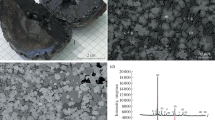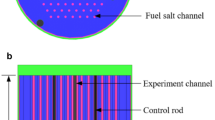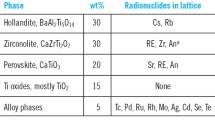Abstract
At the present time the primary problem in a closed nuclear fuel cycle is the management of high level liquid waste (HLLW) generated by the recovery of uranium and plutonium from spent nuclear fuel. Long-term storage of the HLLW, even in special storage facilities, poses a real threat of ecological accidents. This problem can be solved by incorporating the radioactive waste into solid fixed forms that minimize the potential for biosphere pollution by long-lived radionuclides and ensure ecologically acceptable safe storage, transportation, and disposal. In the present report, the advantages of a two-stage HLLW solidification process using a “cold” crucible induction melter (CCIM) are considered in comparison with a one-stage vitrification process in a ceramic melter.
This paper describes the features of a process and equipment for a two-stage HLLW solidification technology using a “cold” crucible induction melter (CCIM) and identifies the advantages compared to a one-stage ceramic melter. A two-stage pilot facility and the technical characteristics of the equipment are described using a once-through evaporator and cold-crucible induction melter currently operational at the IA.Mayak. facility in Ozersk, Russia. The results of pilot-plant tests with simulated HLLW to produce a phosphate glass are described. Features of the new mineral-like waste form matrices synthesized by the CCIM method are also described. Subject to further development, the CCIM technology is planned to be used to solidify all accumulated HLLW at Mayak–first to produce borosilicate glass waste forms and then mineral-like waste forms.
Similar content being viewed by others
References
A. S. Nikiforov, V.V. Kulichenko, M.I. Jiharev. Liquid Radioactive Waste Immobilization., Moscow, Energoatomizdat, 1995.
“Evaluation of Spent Fuel as a Final Waste Form,” Technical reports series, 1991, N 320, Vienna, IAEA, p. 81.
T. Hirabayashi, T. Sato, C. Sagawa, N. M. Masaki, M. Saeki, T. Adachi, Proceedings Int. Conf. RECOD-91, 1991, v. 2, pp. 903–908.
A. Atkinson, A. K. Nickerson, R. J. Taylor, Journal of Materials Science, 1982, v. 17, pp. 2979–2989.
M. Saydler, M. Sappok, “Atomnaya Tehnika za Rubezom”, 1998, v. 2, pp.. 39–41.
A. Jouan, Y. Hery, R. Boen, Proceedings Int. Conf. RECOD - 87, 1987, Paris, France, pp. 723–729.
T. V. Smelova, N. V. Krylova, I. N. Shestoperov, Scientific Basis for Nuclear Waste Management XX, Mat. Res. Soc. Symp., Boston, 1997, v. 465, pp. 425–431.
N. V. Krylova, N. D. Musatov, T. V. Smelova, et al., Proc. Conf. of NS International RF, 1992, pp. 38–46.
V. V. Kushnikov, N. V. Krylova et al., Proc. Mendeleev.s Conf., RF, Moscow, 1993, v. 2, pp. 85–86.
Author information
Authors and Affiliations
Rights and permissions
About this article
Cite this article
Demine, A.V., Krylova, N.V., Polyektov, P.P. et al. High Level Liquid Waste Solidification Using a “Cold” Crucible Induction Melter. MRS Online Proceedings Library 663, 27 (2000). https://doi.org/10.1557/PROC-663-27
Published:
DOI: https://doi.org/10.1557/PROC-663-27




